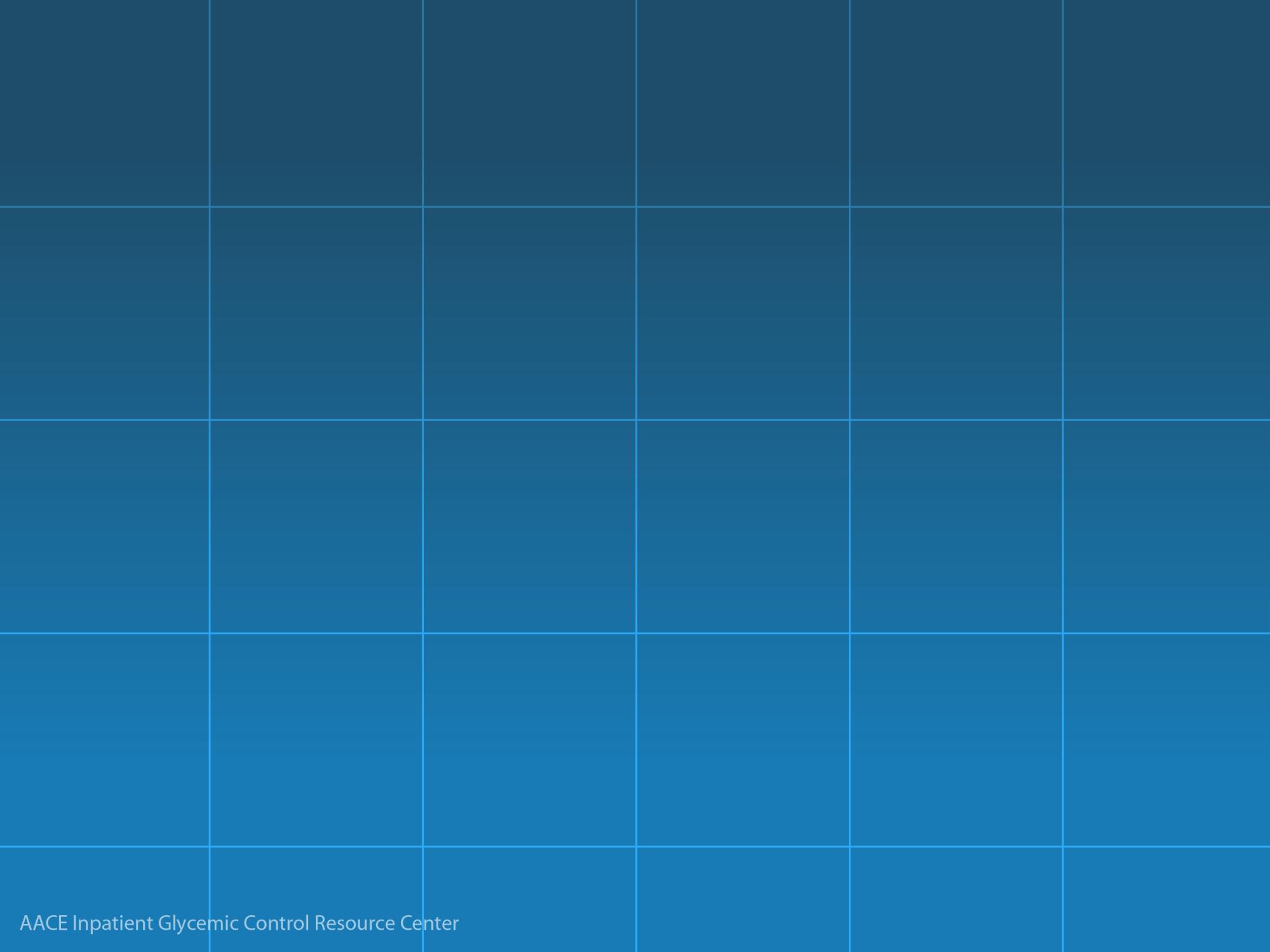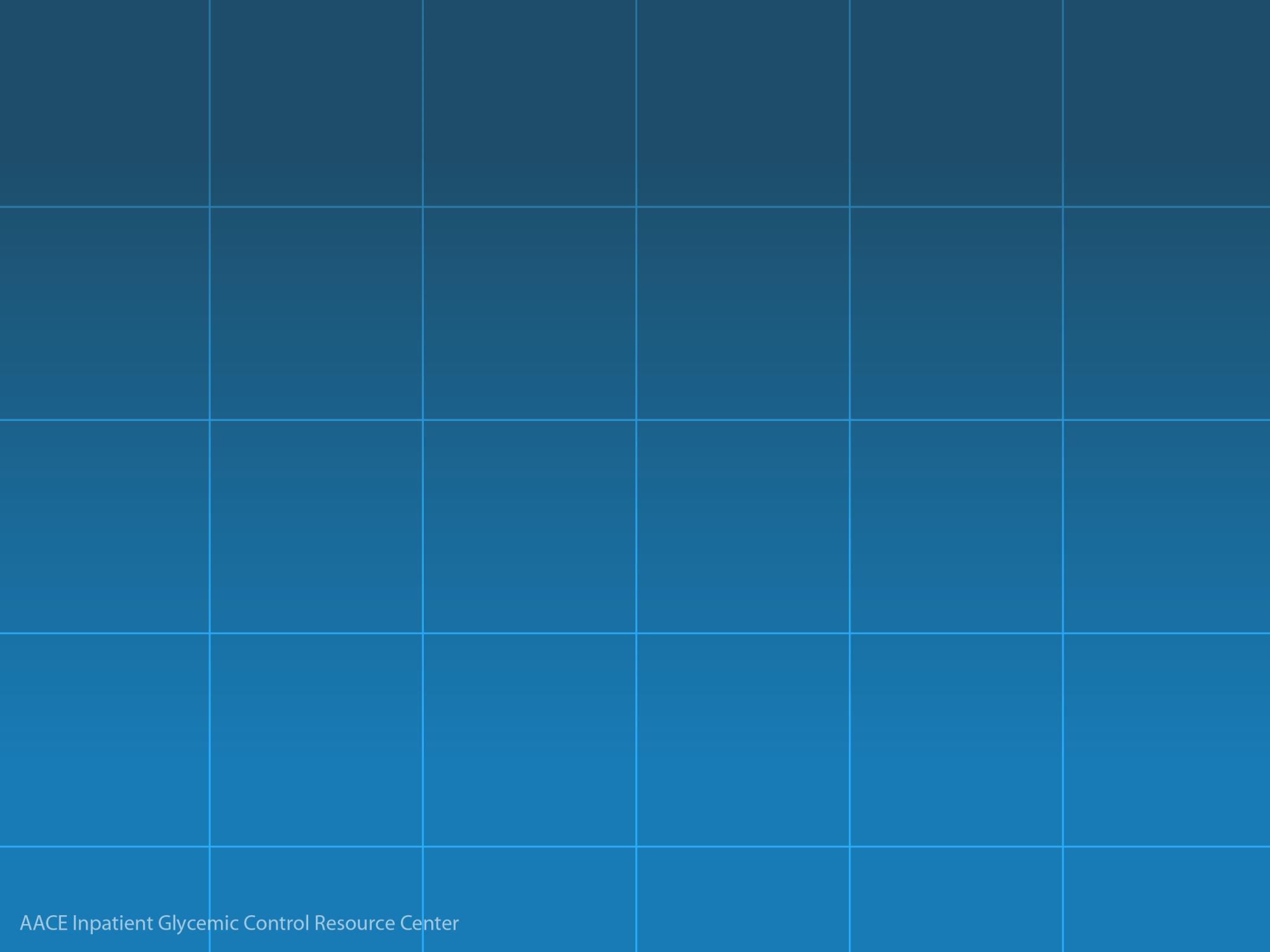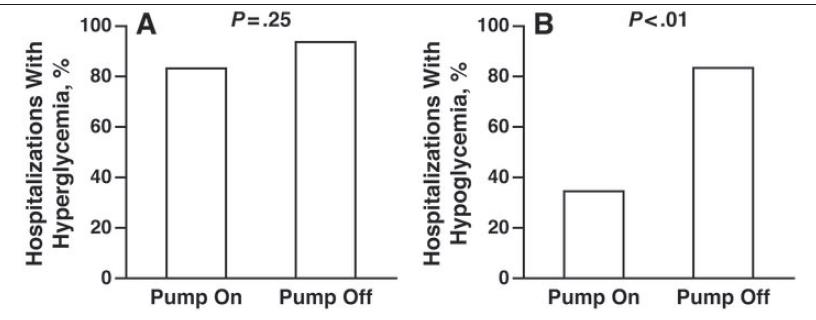Slide
MANAGEMENT OF HYPERGLYCEMIA IN THE
NONCRITICAL CARE SETTING
RECOGNITION AND DIAGNOSIS OF HYPERGLYCEMIA IN NONCRITICALLY ILL PATIENTS
RECOGNITION AND DIAGNOSIS OF HYPERGLYCEMIA AND DIABETES IN THE HOSPITAL SETTING
All patients
– Assess for history of diabetes – Test BG (using laboratory method) on admission independent of prior
diagnosis of diabetes
Patients without a history of diabetes
– BG >140 mg/dL: Monitor with POC testing for 24-48 h – BG >140 mg/dL: Ongoing POC testing – Patients receiving therapies associated with hyperglycemia (eg,
corticosteroids): monitor with POC testing for 24-48 h
• BG >140 mg/dL: continue POC testing for duration of hospital stay
Patients with known diabetes or with hyperglycemia
– Test A1C if no A1C value is available from past 2-3 months
BG, blood glucose; POC, point of care. Moghissi ES, et al.
Endocrine Pract. 2009;15:353-369. Umpierrez GE, et al.
J Clin Endocrinol Metab. 2012;97:16-38.
RECOGNITION AND DIAGNOSIS OF HYPERGLYCEMIA AND DIABETES IN THE HOSPITAL SETTING
• Assess all patients for a history of diabetes • Obtain laboratory blood glucose testing
No history of diabetes
History of diabetes
BG >140 mg/dL
CBG monitoring x 24-48 h
A1C FOR DIAGNOSIS OF DIABETES IN THE HOSPITAL
• Implementation of A1C testing can be useful
– Assist with differentiation of newly diagnosed
diabetes from stress hyperglycemia
– Assess glycemic control prior to admission – Facilitate design of an optimal regimen at the
time of discharge
• A1C >6.5% indicates diabetes
Moghissi ES, et al.
Endocrine Pract. 2009;15:353-369. Umpierrez GE, et al.
J Clin Endocrinol Metab. 2012;97:16-38.
GLYCEMIC GOALS FOR NONCRITICALLY ILL PATIENTS
INPATIENT GLYCEMIC MANAGEMENT: DEFINITION OF TERMS
Hospital
Any BG >140 mg/dL
Elevations in blood glucose levels that occur in patients
with no prior history of diabetes and A1C levels that are
not significantly elevated (<6.5%)
A1C value >6.5%
Suggestive of prior history of diabetes
Any BG <70 mg/dL
Any BG <40 mg/dL
GLYCEMIC TARGETS IN NONCRITICAL CARE SETTING
• Maintain fasting and preprandial BG <140 mg/dL • Modify therapy when BG <100 mg/dL to avoid risk of
• Maintain random BG <180 mg/dL • More stringent targets may be appropriate in stable
patients with previous tight glycemic control
• Less stringent targets may be appropriate in terminally ill
patients or in patients with severe comorbidities
Moghissi ES, et al.
Endocrine Pract. 2009;15:353-369. Umpierrez GE, et al.
J Clin Endocrinol Metab. 2012;97:16-38.
Glucose Monitoring
ACHIEVING GLYCEMIC GOALS IN THE NONCRITICALLY ILL WHILE MINIMIZING HYPOGLYCEMIA RISK
MONITORING GLYCEMIA IN THE NONCRITICAL CARE SETTING
– Preferred method for guiding ongoing glycemic
management of individual patients
– Timing of glucose measures should match patient's
nutritional intake and medication regimen
• Recommended schedules for POC testing
– Before meals and at bedtime in patients who are eating – Every 4-6 h in patients who are NPO or receiving
continuous enteral or parenteral nutrition
BG, blood glucose; POC, point of care. Moghissi ES, et al.
Endocrine Pract. 2009;15:353-369. Umpierrez GE, et al.
J Clin Endocrinol Metab. 2012;97:16-38.
ACHIEVING GLYCEMIC GOALS IN THE NONCRITICALLY ILL WHILE MINIMIZING HYPOGLYCEMIA RISK
MEDICAL NUTRITION THERAPY (MNT)
• MNT is an essential component of the glycemic management
program for all hospitalized patients with diabetes and hyperglycemia
• Providing meals with a consistent amount of carbohydrate can
be useful in coordinating doses of rapid-acting insulin to carbohydrate ingestion
• The hospital Carbohydrate Controlled diet provides an average
of 60 grams of carbohydrate per meal and 30 grams of carb for bedtime snack.
GLYCEMIC MEASURES IN PATIENTS ASSIGNED TO CONSISTENT CARBOHYDRATE OR LIBERAL DIETS IN THE HOSPITAL
CBG values <70 mg/dL were less frequent in patients receiving the
consistent carbohydrate diet (0.4 vs 3.2%,
P=0.06)
Curll M, et al.
Qual Safety Health Care. 2010;19:355-359.
Pharmacologic Therapy
ACHIEVING GLYCEMIC GOALS IN THE NONCRITICALLY ILL WHILE MINIMIZING HYPOGLYCEMIA RISK
PHARMACOLOGICAL TREATMENT OF HYPERGLYCEMIA IN NON-ICU SETTING
Antihyperglycemic Therapy
Oral Antidiabetics
SC Insulin
Recommended for most
medical-surgical patients
Continuous IV Infusion
Selected ICU patients
Umpierrez GE, et al.
J Clin Endocrinol Metab. 2012;97:16-38. Smiley D, et al.
J Hosp Med. 2010;5:212-217.
GLYCEMIC MANAGEMENT STRATEGIES IN NONCRITICALLY ILL PATIENTS
•
Insulin therapy is preferred regardless of type of diabetes
–
Discontinue noninsulin agents at hospital admission on most
patients with type 2 diabetes with acute illness
•
Use scheduled SC insulin with basal, nutritional, and
correction components
– Modify insulin dose in patients treated with Basal insulin before
admission to reduce risk for hypoglycemia and hyperglycemia
"Sliding Scale" insulin alone is not
recommended
INPATIENT MANAGEMENT OF HYPERGLYCEMIA: MANAGING SAFETY CONCERNS
• Both undertreatment and overtreatment of hyperglycemia create safety
•
Areas of risk
– Changes in carbohydrate or food intake – Changes in clinical status or medications – Failure to adjust therapy based on BG patterns – Prolonged use of SSI as monotherapy – Poor coordination of BG testing with insulin administration and meal
– Poor communication during patient transfers – Errors in order writing and transcription
NONINSULIN THERAPIES IN THE HOSPITAL
• Time-action profiles of oral agents can result in delayed
achievement of target glucose ranges in hospitalized patients
• Sulfonylureas are a major cause of prolonged hypoglycemia
• Metformin is contraindicated in patients with decreased renal
function, use of iodinated contrast dye, and any state associated with poor tissue perfusion (CHF, sepsis)
• Thiazolidinediones are associated with edema and CHF
• α-Glucosidase inhibitors are weak glucose-lowering agents
• Pramlintide and GLP-1 receptor agonists can cause nausea and
exert a greater effect on postprandial glucose
Insulin therapy is the preferred approach
SUBCUTANEOUS INSULIN OPTIONS
Controls blood glucose in the fasting state
Basal insulin
•Detemir (Levemir), glargine (Lantus), NPH
Blunts the rise in blood glucose following nutritional intake
Nutritional (prandial) (meals, IV dextrose, enteral/parenteral nutrition)
insulin
•Rapid-acting: lispro (Humalog), aspart (NovoLog), glulisine (Apidra),
Corrects hyperglycemia due to mismatch of nutritional intake
Correction insulin
and/or illness-related factors and scheduled insulin
(sliding scale)
PHARMACOKINETICS OF INSULIN PREPARATIONS
Duration
Nutritional
Rapid-acting analog
(aspart, glulisine, lispro)
Relatively peakless
Relatively peakless
Hirsch I.
N Engl J Med. 2005;352:174-183. Porcellati F, et al.
Diabetes Care. 2007;30:2447-2552.
PHARMACOKINETICS OF INSULIN PRODUCTS
Rapid (lispro, aspart, glulisine)
Short (regular)
Intermediate (NPH)
Long (glargine)
Long (detemir)
Adapted from Hirsch I.
N Engl J Med. 2005;352:174–183.
HEALTHALLIANCE INPATIENT SUBCUTANEOUS INSULIN PROTOCOL
The following is a 4 Step protocol that includes correction insulin (sliding scale), basal insulin and bolus (mealtime) insulin when indicated based on the patient's CBG values.
INITIATING INSULIN THERAPY IN THE HOSPITAL – STEP 1 – ON DAY ONE - DEFAULT ORDERS
Obtain accurate wt in kg
Initiate Hypoglycemic Protocol
Discontinue Oral Anti-diabetics
Nurse to contact MD to start basal insulin if CBG is > 140
mg/dL if not already on basal insulin
HbA1c upon admission
CAPILLARY BLOOD GLUCOSE MONITORING OPTIONS - STEP 1 – ON DAY ONE – CHOOSE ONE
• ACHS for patients that are eating • Every 6 hours for Enteral or Parenteral nutrition
• Every 4 hours
CORRECTION SCALE (SLIDING SCALE) – STEP 2 – ON DAY ONE
• There are
four correction scale options:
Sensitive: pts < 70 kg, pts with renal failure, cirrhosis or
frequent outpt hypoglycemia
Default: use for most patients Resistant: consider for pts with CBG consistently > 300
mg/dL and those on high doses of steroids
Patients that are NPO > 24 hrs or on Enteral or Parenteral
TYPE OF INSULIN TO USE FOR THE CORRECTION SCALE
• Lispro (Humalog): patients that are on
PO diet or NPO patients expected to eat within 24 hours
• Humulin R (Regular): for enteral or
Parenteral nutrition patients only
INSULIN THERAPY – STEP 3 – ON DAY ONE
• If patient already on outpatient Glargine (Lantus)
or Detemir (Levemir), start Glargine at 0.25 units/kg/day
• Special consideration should be given to patients
with renal failure, cirrhosis, frequent outpt hypoglycemia, and the elderly – start Glargine (Lantus) at 0.15 units/kg/day
Umpierrez GE, et al.
Diabetes Care. 2007;30:2181-2186.
INSULIN THERAPY - STEP 3 – ON DAY ONE
• If patient not on outpatient Glargine (Lantus), start
Glargine as follows:
For CBG < 140 mg/dL, do not start Glargine, simply use
correction scale.
For CBG 140-200 mg/dL, start Glargine at 0.2 units/kg/day For CBG 201-400 mg/dL, start Glargine at 0.25
Special consideration should be given to patients with renal failure, cirrhosis, frequent outpt hypoglycemia, and the elderly – start Glargine (Lantus) at 0.15 units/kg/day
INSULIN THERAPY - STEP 4 – ON DAY TWO (OR EARLIER IF 3 CONSECUTIVE CBG VALUES ARE > 200 ) FOR PATIENTS THAT ARE EATING
• For patients receiving Basal Insulin and Correction
(sliding scale) insulin and the
mean daily CBG >
200 mg/dL or
three consecutive CBG are > 200
mg/dL, add bolus (mealtime) insulin.
• This is given with food
in addition to correction
INSULIN THERAPY - STEP 4 – ON DAY TWO (OR EARLIER IF 3 CONSECUTIVE CBG VALUES ARE > 200 MG/DL) FOR PATIENTS THAT ARE EATING
• For CBG 201 – 400 mg/dL, start Lispro (Humalog)
at 0.25 units/kg/day
divided into 3 mealtime boluses.
• Special consideration should be given to patients
with renal failure, cirrhosis, frequent outpt
hypoglycemia, and the elderly – start Lispro
(Humalog) at 0.15 units/kg/day
divided into 3
mealtime boluses.

RISK FACTORS FOR HYPOGLYCEMIA
P value
Variable
Univariate Analysis
Multivariate Analysis*
Previous insulin use
(basal-bolus vs SSI)
Farrokhi F, et al. ADA Scientific Sessions. 2011. Abstr. 2060-PO.
STRATEGIES FOR REDUCING RISK FOR HYPOGLYCEMIA IN NONCRITICAL CARE SETTINGS
• Avoidance of sliding-scale insulin alone
• Use caution in prescribing oral antihyperglycemic
• Modify outpatient insulin doses in patients
treated with insulin prior to admission
Braithwaite SS, et al. Endocr Pract. 2004;10(suppl 2):89-99.
SPECIFIC CLINICAL SITUATIONS: PATIENTS WITH INSULIN PUMPS
• Patients who use CSII pump therapy in the
outpatient setting can continue to use these devices as inpatients provided that they have the mental and physical capacity to do so
• Availability of hospital personnel with expertise in
CSII therapy is recommended
A formal inpatient insulin pump
protocol reduces confusion and
treatment variability
INPATIENT CSII PROTOCOL
• An insulin pump should NEVER be discontinued
without initiation of either subcutaneous or intravenous insulin
• If the pump is discontinued for any reason,
additional insulin (either IV or subcutaneous) MUST be given 30 minutes prior to discontinuation
Noschese ML, et al. Endocr Pract. 2009;15:415-424.
HealthAlli
ance has an Insulin Pump Protocol
ient gets screened for ability to manage insulin pump
upon admi
ssion and each shift.
Patient must meet criteria per Insulin Pump Protocol to keep
insulin pump during hospital stay.
MD role is to complete Inpatient Insulin Pump Physician orders and to consult provider managing pump in community or consult endo.


INPATIENT CSII THERAPY
Prevalence of hyperglycemia and hypoglycemia in
inpatients who continued (pump on) or discontinued
(pump off) CSII during their hospital stay
Bailon RM, et al. Endocr Pract. 2009;15:24-29.
• Target BG: 100-180 mg/dL for most noncritically
• Insulin therapy preferred method of glycemic
control in the hospital
• Scheduled SC basal-bolus insulin therapy is
effective and safe for treatment of hyperglycemia in noncritically ill patients
• Sliding scale insulin alone is inappropriate once
an insulin requirement is established
Source: http://www.hahv.org/wp-content/uploads/2016/03/Management-of-Hyperglycemia-Presentation.pdf
UNITED NATIONS CONVENTION AGAINST ILLICIT TRAFFIC IN NARCOTIC DRUGS AND PSYCHOTROPIC SUBSTANCES The Parties to this Convention, Deeply concerned by the magnitude of and rising trend in the illicit production of, demand for and traffic in narcotic drugs and psychotropic substances, which pose a serious threat to the health and
Microbiology Microbiology In Vitro Diagnostics In Vitro Diagnostics Viale Monza 272, 20128 Milan, Ital ale Monza 272, 20128 Milan, Italy PRODUCTS Dehydrated Culture Media Selective Supplements and Enrichments Ready to use media in plates, tubes, bottles Rapid Latex Test Specimen Collections and Tranport



